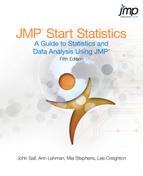 Control Charts and Capability
by Lee Creighton, Mia Stephens, Ann Lehman, Ph.D., John Sall
JMP Start Statistics, 5th Edition
Control Charts and Capability
by Lee Creighton, Mia Stephens, Ann Lehman, Ph.D., John Sall
JMP Start Statistics, 5th Edition
- Preface
- Preliminaries
- JMP Right In
- Data Tables, Reports, and Scripts
- Formula Editor Adventures
- What Are Statistics?
- Simulations
- Univariate Distributions: One Variable, One Sample
- Overview
- Looking at Distributions
- Describing Distributions of Values
- Statistical Inference on the Mean
- Practical Significance vs. Statistical Significance
- Examining for Normality
- Special Topic: Practical Difference
- Special Topic: Simulating the Central Limit Theorem
- Seeing Kernel Density Estimates
- Exercises
- The Difference Between Two Means
- Overview
- Two Independent Groups
- When the Difference Isn’t Significant
- Check the Data
- Launch the Fit Y by X Platform
- Examine the Plot
- Display and Compare the Means
- Inside the Student’s t-Test
- Equal or Unequal Variances?
- One-Sided Version of the Test
- Analysis of Variance and the All-Purpose F-Test
- How Sensitive Is the Test? How Many More Observations Are Needed?
- When the Difference Is Significant
- Normality and Normal Quantile Plots
- Testing Means for Matched Pairs
- Two Extremes of Neglecting the Pairing Situation: A Dramatization
- A Nonparametric Approach
- Exercises
- Comparing Many Means: One-Way Analysis of Variance
- Fitting Curves through Points: Regression
- Categorical Distributions
- Categorical Models
- Overview
- Fitting Categorical Responses to Categorical Factors: Contingency Tables
- Two-Way Tables: Entering Count Data
- If You Have a Perfect Fit
- Special Topic: Correspondence Analysis— Looking at Data with Many Levels
- Continuous Factors with Categorical Responses: Logistic Regression
- Surprise: Simpson's Paradox: Aggregate Data versus Grouped Data
- Generalized Linear Models
- Exercises
- Multiple Regression
- Fitting Linear Models
- Overview
- The General Linear Model
- Kinds of Effects in Linear Models
- Coding Scheme to Fit a One-Way anova as a Linear Model
- Regressor Construction
- Interpretation of Parameters
- Predictions Are the Means
- Parameters and Means
- Analysis of Covariance: Continuous and Categorical Terms in the Same Model
- The Prediction Equation
- The Whole-Model Test and Leverage Plot
- Effect Tests and Leverage Plots
- Least Squares Means
- Lack of Fit
- Separate Slopes: When the Covariate Interacts with a Categorical Effect
- Two-Way Analysis of Variance and Interactions
- Optional Topic: Random Effects and Nested Effects
- Exercises
- Design of Experiments
- Bivariate and Multivariate Relationships
- Exploratory Modeling
- Control Charts and Capability
- Mechanics of Statistics
- Analyze and Graph Menu Commands
- Answers to Selected Exercises
- Chapter 4, "Formula Editor Adventures"
- Chapter 7, "Univariate Distributions: One Variable, One Sample"
- Chapter 8, "The Difference Between Two Means"
- Chapter 9, "Comparing Many Means: One-Way Analysis of Variance"
- Chapter 10, "Fitting Curves through Points: Regression"
- Chapter 11, "Categorical Distributions"
- Chapter 12, "Categorical Models"
- Chapter 13, "Multiple Regression"
- Chapter 14, "Fitting Linear Models"
- Chapter 15, "Design of Experiments"
- Chapter 16, "Bivariate and Multivariate Relationships"
- Chapter 17, "Exploratory Modeling"
- Chapter 18, "Control Charts and Capability"
- References and Data Sources
- Technology License Notices
- Index
18
Control Charts and Capability
Overview
Some statistics are for proving things. Some statistics are for discovering things. And, some statistics are to keep an eye on things, watching to make sure something stays within specified limits.
The watching statistics are needed mostly in industry for production processes that sometimes stray from proper adjustment. These statistics monitor variation, and their job is to distinguish the usual random variation (called common causes) from abnormal changes (called special causes).
These statistics are usually from a time series, and the patterns they exhibit over time are clues to what is happening to the production process. If they are to be useful, the data for these statistics need to be collected and analyzed promptly so that any problems they detect can be fixed.
The use of SQC techniques became popular in the 1980s as industry began to better understand the issues of quality, after the pioneering effort of Japanese industry and under the leadership of W. Edwards Deming and Joseph Juran.
This whole area of statistics is called Statistical Process Control (SPC) or Statistical Quality Control (SQC). The most basic tool is a graph called a control chart (or Shewhart control chart, named for the inventor, Walter Shewhart). In some industries, SQC techniques are taught to everyone—engineers, mechanics, shop floor operators, even managers.
In addition to control charts, JMP offers many quality and process tools, such Pareto charts, measurement systems analysis, capability analysis, and cause and effect diagrams (also known as fishbone charts or Ishikawa diagrams).
This chapter provides an overview of control charts and process capability studies.
-
No Comment
..................Content has been hidden....................
You can't read the all page of ebook, please click here login for view all page.